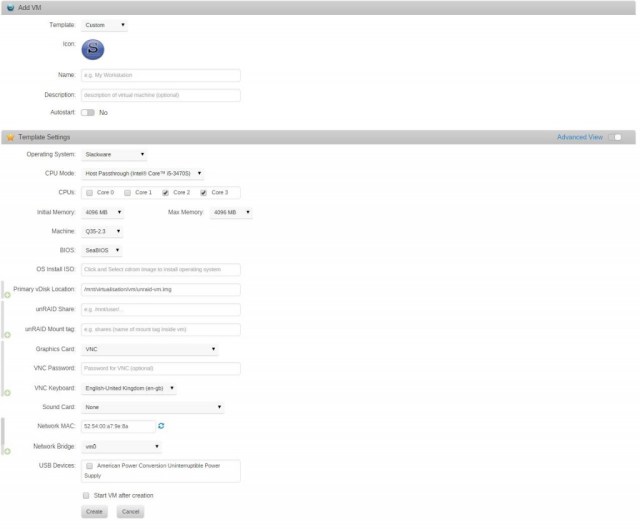

- #UNRAID SETUP VIRTUAL MACHINE HOW TO#
- #UNRAID SETUP VIRTUAL MACHINE INSTALL#
- #UNRAID SETUP VIRTUAL MACHINE UPDATE#
For the rest of the fields, you can leave them as default unless I say otherwise. Give it whatever name and description you want. My current Unraid server configuration consists of a Dell r720xd with an assortment of mixed size drives:ĭell r720xd LFF (12 x 3.5 hdd bays, 2 x 2. Head over to the VMS tab of your unRAID server, click Add VM and then click Windows 10. My current Grafana dashboard for Unraid looks like this: Grafana dashboard for Unraid Unraid Server To import this, go to the import option in your Grafana installation and enter 7233 when asked for the dashboard ID. You can search “Unraid” here: to see what others have created.Ī very robust dashboard is # 7233. I recommend importing an existing dashboard to give you some ideas on how the data can be visualized in Grafana. There are a number of really great dashboards that can help you get started.

If not, add that under Configuration > Data Sources > Add data source. Get more out of your Unraid server with those leftover. This the perfect lightweight solution rather than using a virtual machine or a dedicated PC.
#UNRAID SETUP VIRTUAL MACHINE UPDATE#
This guide is an update to the Multi-Streaming Server blog. This is the updated 2021 guide for setting up an OBS NDI container in Unraid 6.9. We’ll assume you already have a the InfluxDB data source setup. Unraid 6.9 Capture, Encoding, and Streaming Server. It should look something like this: InfluxDB data from Unraid Step 6. Run a quick query to make sure you are getting data from Unraid: select * from cpu where time > now()-10s Select the database where your Unraid data is being sent: use telegraf ssh to InfluxDB influx -username admin -password YOURPASSWORD Log into the system where your InfluxDB is installed. Uncomment (remove the # character) from the following plugins: ]Ĭtrl+O and then hit return to write the file. nano /mnt/cache/appdata/telegraf/nfĬhange the InfluxDB settings to the location of your InfluxDB: InfluxDB settings in Telegraf config file Note: If you have already run mover after you installed Telegraf, you will need to use /mnt/user/appdata/telegraf/nf. I’m using the Unraid web terminal to do the following: rm -rf /mnt/cache/appdata/telegraf/nf If you want to leave the default container settings this needs to be removed and replaced with an actual file.
#UNRAID SETUP VIRTUAL MACHINE INSTALL#
Note: For some reason this directory is created during install (at least for me). You can also specify a different location under the Telegraf docker container settings.įirst, I’m deleting the nf directory that was created during the Telegraf installation. We need to place that in the /mnt/user/appdata/telegraf/ folder. We need to manually add the Telegraf configuration file before we can start Telegraf. You should see both docker containers under the docker section in Unraid: HDDTemp and Telegraf dokcers in Unraid Step 3. I’m also going to leave the default settings for the Telegraf installation: Telegraf docker installation Next, install the Telegraf docker (choose the one with the green thumb): Telegraf docker in Unraid I used the default settings and clicked “Apply”. First, let’s add HDDTemp: HDDTemp Docker in Unraid Start there if you don’t have InfluxDB and Grafana installed. Grafana and InfluxDB are installed on a virtual machine and will collect the data sent from other services and machines in my homelab.
#UNRAID SETUP VIRTUAL MACHINE HOW TO#
In a previous post I walked through how to setup Grafana for your homelab.


 0 kommentar(er)
0 kommentar(er)
